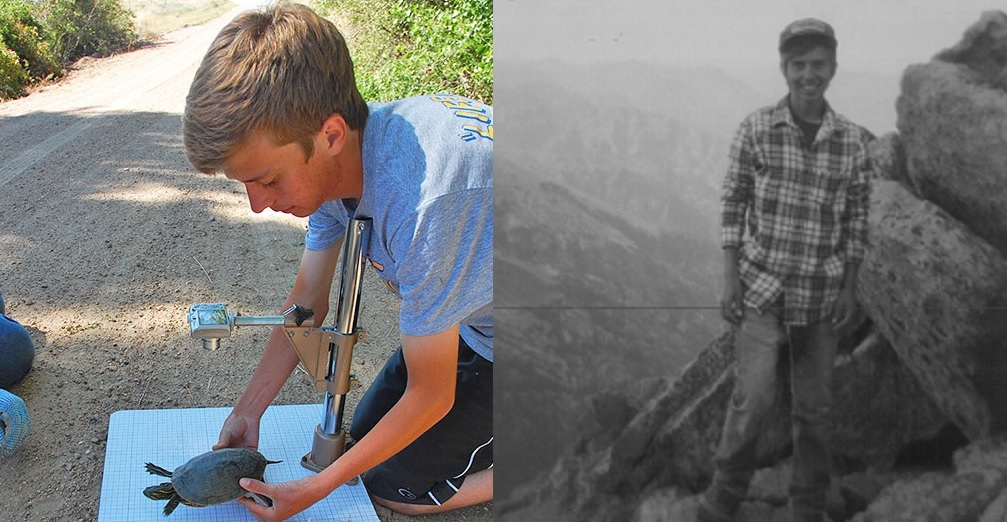
Graduating college with a 4.0 grade point average is no easy feat, and Ian Hoppe is well-aware of how much work goes into maintaining a perfect GPA.
"In some ways, I have had to make certain concessions in order to maintain a high academic standing," said Hoppe, a senior fisheries and wildlife major who is graduating this week. "Though I never feel comfortable with a term until it is over – and that applies to this current semester as well."
While Hoppe won't know whether he's leaving the university with that flawless 4.0 until final grades are turned in, if his academic record is any indicator, he shouldn't be too concerned.
"Ian is a top-notch student in the classroom," said Larkin Powell, professor of conservation biology and wildlife ecology who served as Hoppe's UCARE faculty adviser.
For two years, Hoppe participated in UCARE, the university's undergraduate research program, and worked on two projects with Powell. One project involved collecting data from turtle populations at multiple ponds near Cedar Point Biological Station in Ogallala, Nebraska.
"In this case, it was a way for me to work with a student one-on-one and learn from him as well as vice versa," Powell said. "He spent a week at Cedar Point with my entire family, and these are the type of student-professor experiences that we strive to find."
Hoppe said that his UCARE involvement was a multilayered learning experience.
"I have greatly enjoyed the process of approaching a question and trying to find an appropriate means of answering it, then gathering and looking at the necessary data," Hoppe said. "At the same time, I have gained a greater appreciation for the challenge facing wildlife biologists and others in the field in trying to find feasible solutions to complex problems – it can certainly be a daunting task, and you often don't have much from which to draw."
Despite being exposed to those obstacles, Hoppe's UCARE research was not in vain.
"Ian designed a photographic stand and technique that allowed him to precisely photograph the shells of each turtle to compare the symmetry of their scutes and overall shell," Powell said. "His ingenuity was the basis for his research success."
Outside of his academic studies and research, Hoppe knows a thing or two about being involved.
From working at the Tern and Plover Conservation Partnership to volunteering at the University of Nebraska State Museum and at the Lincoln Children's Zoo, the Wahoo, Nebraska native always finds ways to stay active in the community.
"I have really enjoyed spending time volunteering at the museum (and) preparing specimens for the collection," Hoppe said. "I think it has helped prepare me somewhat for a career in veterinary medicine, as I get to explore vertebrate anatomy in more detail than is possible even in most laboratory-based classes."
Indeed, all of that hands-on experience will aid Hoppe on his postgraduate path of pursuing a degree in veterinary medicine.
"Eventually, I would like to spend time working and traveling abroad providing veterinary care to communities and individuals with limited access to such services, but who rely on maintaining herd health for their livelihoods," Hoppe said.
He is also interested in working as a veterinarian for a conservation organization or zoological institute – among other ambitions.
"The field of natural resources and of conservation is broad indeed," Hoppe said. "At times, I feel that there are so many exciting and intriguing avenues in the field that the selection of one, or even a few, seems a missed opportunity."
Wherever the future may lead, Hoppe said that SNR has helped him sort through the overwhelming amount of options that lay ahead.
"I have thoroughly enjoyed all of the internships and experiences that I've been involved with through SNR, and yet they all seem to represent distinct areas within conservation biology," he said. "While I can't say that I have overcome this challenge per se, I think that I have succeeded in selecting a career path that I hope will allow me to combine these various passions – for wildlife conservation, for science and for medicine – into a future with promise."
— Mekita Rivas, Natural Resources
Do you know a stellar SNR student who should be spotlighted in an issue of Inside SNR? Send his or her contact information to mrivas@unl.edu.